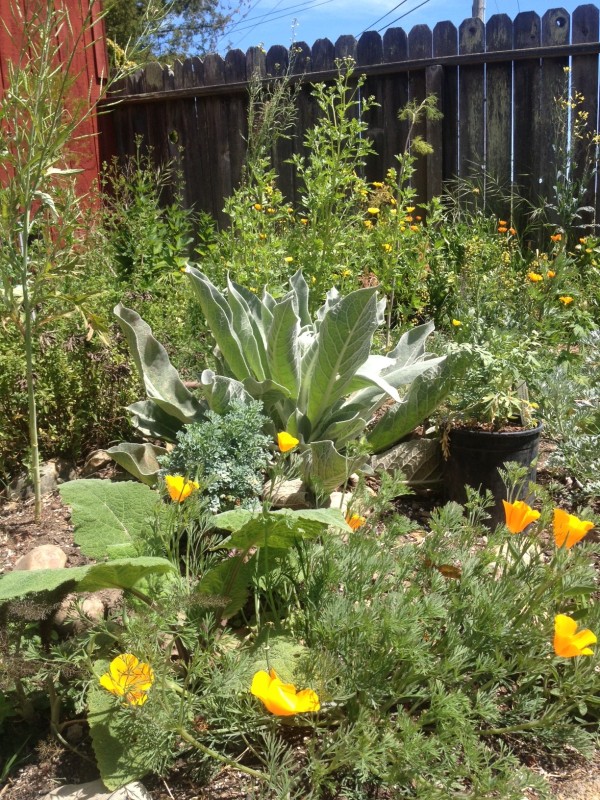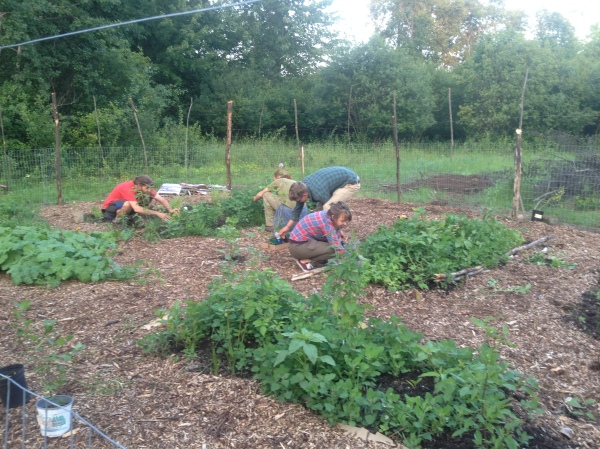The following is an excerpt from a Q&A I did with Stephanie Van Hook of the Metta Center for Nonviolence. For the complete interview see the Winter/Spring 2017 issue of Nonviolence Magazine.

Stephanie: Gandhi created models of Transition Towns during his campaigns, but he called them ashrams, or spiritual communities. How do you see the Transition movement fitting into the nonviolent revolution — building the world that works for everyone?
Marissa: Much of the violence in our society is the result of an economic system based on exploitation and extraction and an accompanying culture of disconnection and isolation. Racial injustice, extreme wealth inequality and even terrorism are all tied to the violent and oppressive methods the dominant economy utilizes to extract resources, exploit labor and consolidate wealth.
Transition was created to be a model for empowering individuals to take constructive action in creating a world free from dependence on fossil fuels and a violent economic system, while at the same time re-weaving the fabric of community and connection.
Transition communities are re-imagining and re-designing the vital systems upon which we depend (food, water, energy, transport, housing, healthcare, etc.) to be community-oriented and ecologically regenerative. Like Gandhi’s cotton campaign, Transition — and countless other organizations and movements around the world — are building an alternative economy from the bottom up, an economy that will someday either displace the dominant extractive economy or serve as a lifeboat when the dominant economy collapses. Look at what has happened in places like Greece and Spain, where economic collapse has led to the rise of solidarity, gift and sharing economies. People are coming together and helping each other meet their basic needs.

Stephanie: The Metta Center for Nonviolence encourages people in the nonviolent movement to personalize their relationships. How do Transition communities build supportive, nurturing systems that undermine separation and competition?
Marissa: Transition is all about relationships and mutual support: we believe connected communities are the foundation of the social change and ecological resilience we need in order to survive as humanity on this planet.
We strive to create localized communities where people know their neighbors and see each other as friends and resources; where the economy is based on relationships, and businesses exist to serve the community rather than extract wealth and resources; where elders are valued and integrated into society; where diversity is seen as beneficial and where fewer people are marginalized, vulnerable or isolated.
As much as we can, we embody these ideals in our daily lives, and we know at a visceral level what kind of societal transformation will be possible once this fabric of community and connection really spreads and permeates our culture.
One of the most inspiring and unique things about Transition is the type of people it attracts: folks who are warm, open-hearted, welcoming, tolerant, caring, generous.They share a positive vision of the future (despite being all too aware of the realities of the world in which we live). I know I can visit any Transition Initiative in the US and meet people who feel like family, who will open up their homes and share meals with me. And I will return the hospitality.
Stephanie: What community guidelines might people consider adopting, based on the experiences of those in the Transition US movement?
Marissa: We don’t have any official guidelines, but rather a collective culture or ethos. Here are a few informal guidelines for developing a more resilient community:
- Get to know your neighbors — by more than just their first name.
- Reduce consumption — buy less “stuff” and use less energy.
- Support local food producers and resilient regional food systems.
- Know your watershed, and use water wisely.
- Support local, independent and resilience-building businesses.
- Switch to community-scale, renewable energy sources.
- Walk, bike, carpool or use public transportation when possible, rather than driving a personal vehicle. Avoid flying, especially long distances.
- Reduce waste, recycle and start composting.
- Build resilience on your street and in your neighborhood by using Transition Streets, facilitating an emergency preparedness plan or holding block parties
- Collaborate with community groups, schools, libraries and more.
- Get involved in local government. Show up to city council meetings, hold your elected officials accountable, collaborate with local government agencies or run for office. Develop your own person power — your inner strength, resilience and self-awareness.
- Hone your skills in effective collaboration and conflict resolution.
Stephanie: What are some key skills that help people in the Transition US movement feel most effective and inspired in their daily labors?
Marissa: Great question! Becoming an effective, inspired Transitioner is a constant process — this is challenging, cutting-edge work. We have a huge mission and a small budget, so we have to be very resourceful and conscious of avoiding overwhelm. Here are some of the skills I see as especially important:
- Systemic thinking: understanding the interconnectedness of the systems we depend on. Since most of our civilization depends on fossil fuels to function, getting off fossil fuels requires much more than putting up solar panels. We need to redesign our food, water and sanitation, transportation, housing, healthcare and manufacturing systems and so much more. We need to think long-term and understand the impacts our choices as consumers and citizens have on the big picture.
- Community organizing: convening people around an important issue, inviting real participation, designing and executing a campaign or project and creating a sense of community ownership over the process and outcome. This does not come naturally to everyone, but there are many resources and trainings you can draw from to learn and practice.
- Good social and collaboration skills: self-awareness, conscious communication, conflict resolution, etc. The hardest thing about working with people is the people! This is especially true in a collaborative, egalitarian, post-hierarchical setting (like most Transition Initiatives). In order to work effectively as a group, you need to be very aware of the way you yourself are showing up and participating, and be well-equipped to navigate interpersonal challenges with other members of your group. Transition US provides a lot of resources to support Transitioners in developing these skills, like our “Effective Groups” and “Power of Conflict for Building Community” trainings.
- Permaculture/homesteading/DIY/renewable energy, etc.: hands-on, concrete skills that you can use to build resilience in your own life and share with others. Teaching hands-on skills is a fun, empowering way to engage people in Transition, and it tends to be more successful than preaching about what people should or shouldn’t be doing. We call this type of hands-on learning “reskilling.” Hands-on skills also provide a balance to the community organizing and advocacy work, where you don’t always see the direct results of your efforts. I know many Transitioners who relax by getting their hands in the dirt and growing things.
- Inner resilience: personal practices to help you avoid burnout and be able to face the realities of the world we live in without being paralyzed by anger, grief or fear. I think this is part of what the Metta Center for Nonviolence would call “person power.” An important piece of Transition is our “Inner Transition” work, which helps us build inner resilience through positive visioning. Our Western culture (especially in the US) tends to be more action-oriented than contemplative, so we also strive for a sense of balance between being and doing.
- Movement-building: collaboration with other community groups and local governments in order to expand our base and grow our impact, as well as collaboration with the broader Transition movement to craft a shared narrative and strategy.

For the complete interview see the Winter/Spring 2017 issue of Nonviolence Magazine.